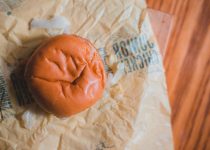How to Make a Rotisserie Chicken in Oven
Want to know the secret to making the most succulent, flavorful rotisserie chicken in your own oven? It's easier than you think!
With just a few simple steps, you can achieve that perfect golden-brown skin and juicy, tender meat that will have everyone thinking you picked it up from a fancy rotisserie shop.
So, roll up your sleeves, grab your favorite seasonings, and let's get cooking. This guide will walk you through the process, from seasoning the chicken to carving it like a pro.
Get ready to impress your friends and family with your newfound rotisserie chicken mastery!
Key Takeaways
- Season the chicken with a mixture of herbs and spices, ensuring every inch is coated.
- Truss the chicken to help it cook evenly and retain its shape.
- Preheat the oven to 425°F for optimal cooking and to lock in juices.
- Use a meat thermometer to check the internal temperature of the chicken, which should reach 165°F for doneness.
Season the Chicken
To season the chicken, start by rubbing a mixture of your chosen herbs and spices all over the surface of the bird. This step is crucial for infusing the meat with delicious flavors.
Flavorful marinades are a great way to add depth and complexity to your rotisserie chicken. You can use a combination of oil, acid (like lemon juice or vinegar), and seasonings to create a mouthwatering marinade. Alternatively, you can opt for dry rubs and spices. These are perfect for creating a tasty crust on the chicken while locking in moisture.
When choosing your herbs and spices, consider using a blend of garlic powder, onion powder, paprika, salt, and pepper for a classic and savory flavor profile. If you prefer a more aromatic and herbaceous taste, try mixing thyme, rosemary, oregano, and lemon zest. Experiment with different combinations to find the perfect flavor for your rotisserie chicken.
Remember to be generous with your seasoning, ensuring that every inch of the chicken is coated for a truly delectable outcome.
Truss the Chicken
Now that your chicken is seasoned and ready to go, it's time to truss it up!
Trussing your chicken is important because it helps it cook evenly and keeps the meat juicy and tender.
It's like giving your chicken a cozy little hug to make sure it turns out perfectly delicious.
Properly Tie Chicken
Once you have seasoned the chicken, use kitchen twine to truss the chicken before roasting it in the oven. Trussing the chicken ensures that it cooks evenly and retains its moisture, resulting in a juicy and tender meat. Properly tying the chicken also helps it maintain a compact shape, which makes for a more appealing presentation when serving. Here are some knot tying techniques and roasting tips to help you properly tie the chicken:
| Knot Tying Techniques | Roasting Tips |
|---|---|
| Start with a long piece of twine and place the chicken on a clean surface. | Preheat the oven to the recommended temperature. |
| Cross the twine under the tail of the chicken and pull it tightly to secure. | Place the trussed chicken on a roasting rack in a shallow roasting pan. |
| Bring the twine around the sides of the chicken and tie it securely, ensuring the wings and legs are snug against the body. | Baste the chicken with melted butter or olive oil to enhance browning. |
Secure for Even Cooking
Securing the chicken for even cooking involves trussing it properly before placing it in the oven. Trussing ensures that the chicken cooks evenly, preventing the wings and legs from getting overcooked.
To truss the chicken, start by tucking the wings underneath the body. Then, using kitchen twine, tie the legs together firmly. If you're using a rotisserie attachment, make sure the chicken is securely fastened to the spit, ensuring it rotates evenly for uniform cooking.
Properly trussing the chicken not only aids in even cooking but also gives the bird a nice, compact shape. This step is crucial for achieving that juicy, succulent meat.
Additionally, trussing can help reduce cooking time, ensuring that the chicken cooks through evenly without any dry spots.
Preheat the Oven
Preheating your oven to 425°F is the first step in making a delicious rotisserie chicken at home. Ensuring that your oven is properly preheated is crucial for achieving that perfect juicy and crispy chicken. Here's what you need to do:
- Achieve Optimal Flavor: Preheating the oven allows the chicken to start cooking immediately at the right temperature, locking in the juices and ensuring a moist and flavorful end result.
- Even and Consistent Cooking: A properly preheated oven ensures that the chicken cooks evenly throughout, giving you that ideal golden-brown skin and juicy, tender meat.
- Efficiency: By preheating your oven, you optimize the cooking time, getting your rotisserie chicken on the table faster without compromising on taste or texture.
- Create a Delicious Aroma: As the oven preheats and the chicken begins to cook, the tantalizing aroma of herbs and spices will start wafting through your kitchen, building anticipation for the mouthwatering meal to come.
Roast the Chicken
Now that the oven is preheated, it's time to get that chicken roasting!
First, season the chicken generously to infuse it with flavor.
Then, truss the chicken to ensure even cooking throughout.
Season for Flavor
You'll want to regularly baste the chicken with the seasoned juices while it's roasting in the oven. This will help lock in the moisture and infuse the chicken with a rich, savory flavor.
Here are some seasoning techniques to ensure your rotisserie chicken is bursting with deliciousness:
- Dry Rub: Massage a blend of your favorite herbs and spices onto the chicken for a robust, fragrant flavor.
- Citrus Infusion: Squeeze fresh lemon or orange juice over the chicken to add a zesty, tangy kick.
- Herb Butter: Spread a mixture of softened butter and fresh herbs under the skin for a luxurious, aromatic taste.
- Garlic and Onion: Layer slices of garlic and onion on top of the chicken to create a deeply savory, aromatic profile.
These methods will elevate your rotisserie chicken to a whole new level of deliciousness!
Truss for Even Cooking
To ensure even cooking and a beautifully golden exterior, truss the chicken before roasting it in the oven. This will help the chicken retain its shape and cook more evenly, resulting in a juicy and tender final product.
Trussing involves tying the chicken with kitchen twine to secure the wings and legs against the body. To start, place the chicken breast-side up and tuck the wings behind the back. Then, cut a piece of twine and loop it around the drumsticks, pulling them together tightly and tying a knot.
Next, loop the twine around the wings and pull them in towards the body, tying another knot to secure. This technique not only promotes even cooking but also enhances the presentation of the finished dish.
Trussing ensures that the chicken cooks uniformly, creating a delightful dining experience.
Monitor Internal Temperature
To ensure that the chicken is perfectly cooked, monitor its internal temperature throughout the roasting process. Properly cooked chicken should reach an internal temperature of 165°F (73.9°C).
Here's how to ensure your chicken is cooked to perfection:
- Internal Temperature: Use a meat thermometer to check the internal temperature of the thickest part of the chicken, avoiding the bone.
- Cooking Time: Be mindful of the cooking time, but remember that internal temperature is the most accurate indicator of doneness.
- Thermometer Placement: Insert the thermometer into the thigh, making sure not to touch the bone for an accurate reading.
- Checking for Doneness: Look for juices running clear and the skin being golden brown, but always rely on the internal temperature for certainty.
Check for Doneness
Check the internal temperature of the chicken using a meat thermometer to ensure it has reached 165°F. This is the safest way to determine if your rotisserie chicken is thoroughly cooked. Once the chicken has reached the recommended temperature, it's time to perform a juiciness test and visually inspect the chicken.
Checking for Doneness
| Doneness Test | Description | Result |
|---|---|---|
| Temperature check | Insert a meat thermometer into the thickest part of the chicken without touching bone. The temperature should read 165°F. | Chicken is safe to eat when it reaches 165°F. |
| Juiciness test | Pierce the chicken with a fork or knife. If the juices run clear, the chicken is done. | Clear juices indicate the chicken is fully cooked. |
| Visual inspection | The chicken should have a golden brown color with crispy skin. The meat should be opaque and no longer pink. | Golden brown color with opaque, non-pink meat. |
Rest and Carve
After roasting, let the chicken rest for 10 minutes before carving to ensure juiciness and tenderness. This resting period allows the juices to redistribute, resulting in a more succulent and flavorful chicken.
Once rested, it's time to carve your perfectly roasted chicken. Here are some simple carving techniques to help you master this essential skill:
- Sharp Knife: A sharp knife is crucial for clean and precise cuts. Dull knives can tear the meat, leading to less visually appealing slices.
- Breast Slicing: Start by slicing along the breastbone to remove the entire breast in one piece. Then, carve thin, even slices against the grain for maximum tenderness.
- Thigh and Leg Separation: Gently pull the thigh away from the body and slice through the joint to separate the thigh and leg. Repeat on the other side.
- Wing Removal: Finally, remove the wings by slicing through the joints where they meet the body, ensuring you get all the flavorful meat.
Mastering these carving techniques and allowing the chicken to rest will elevate your rotisserie chicken game, resulting in a delicious and impressive dish for any occasion.
Frequently Asked Questions
Can I Use a Different Type of Meat Instead of Chicken for This Recipe?
You can definitely switch up the meat in this recipe. Experiment with pork, turkey, or even lamb for tasty variations. The cooking process remains similar, so feel free to get creative with alternative meats.
How Long Can I Store Leftover Rotisserie Chicken in the Refrigerator?
You can store leftover rotisserie chicken in the refrigerator for up to 3-4 days, but always check for any signs of spoilage. It's crucial to follow food safety guidelines for proper storage and enjoy it in various leftover recipes for meal planning.
Can I Use a Different Seasoning Blend for the Chicken?
You can definitely use a different seasoning blend for the chicken! Just adjust the amount to your taste. Keep an eye on the cooking time and ensure the oven temperature is suitable for the alternative meat.
What Temperature Should the Oven Be Set to for Roasting the Chicken?
Set your oven temperature to 375°F for roasting the chicken. This ensures even cooking and a juicy bird. If you're trying a different seasoning blend or meat substitution, adjust the cooking time as needed. Enjoy!
Can I Use a Different Type of Pan for Roasting the Chicken?
You can use a different type of pan for roasting the chicken, like a cast-iron skillet or a roasting pan. Experiment with cooking techniques and seasoning options to find what works best for you.



